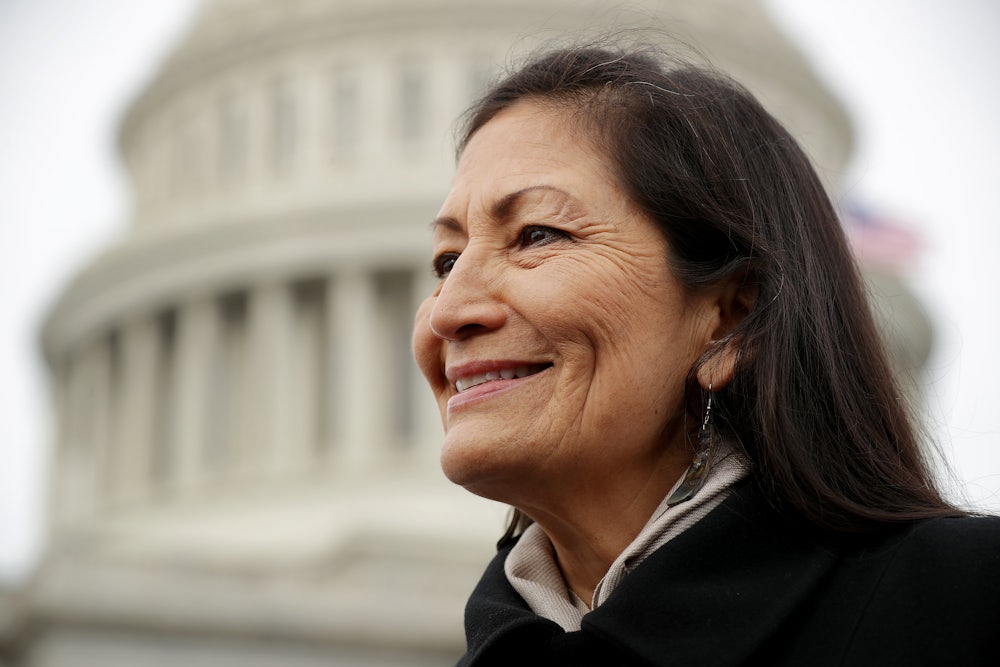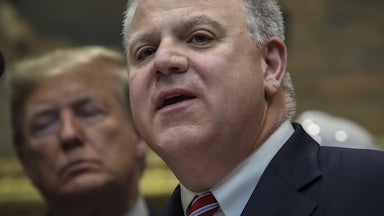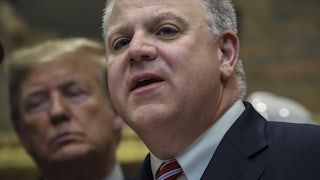Deb Haaland could be the next secretary of the interior. Her hearing is scheduled for Tuesday and, if seated, the congresswoman from New Mexico and citizen of the Laguna Pueblo will make history. Her name will be etched into the minds of young Native women across Indian Country, and her late-career path to Congress and then the Cabinet will serve as an inspiration to any Native person who believes that such offices are the places where change happens.
Maybe you already know this. There has been no shortage of laudatory coverage of Haaland’s appointment. Given the decades of invisibility that Native people have faced, both in government and in media, the coverage has been, like Haaland’s nomination, a welcome surprise. It has also flattened the complexities of the moment.
The grand myth of the power of political representation—of having a seat at the table—is the primary lens through which most “firsts” are filtered. It makes sense on a certain level. Landing Native officials like Haaland, a progressive lawmaker who is in support of tribal consultation and the reduction of extractive fossil fuel activities on Native and public lands, in positions of power is an important step toward ensuring Indigenous voices are heard and amplified within the American government. With nobody to represent the interests of tribal nations and communities, those interests will go silenced or unheard.
But we cannot forget an unfortunate truth that history has taught us many times over. Ensuring the well-being of Indigenous communities is, as it has been for centuries, a legal mandate that the federal government feels comfortable breaking with each annual budget. And while Haaland’s appointment has rightly been recognized as historic, Native people have occupied positions of great power within that colonial machine, many of them seeking to ensure those mandates are followed, only either to leave embittered or transition themselves into an active participant in the grand American tradition of treaty-breaking and excuse-making. Haaland has the potential to overcome these structural roadblocks and deliver justice for the unheard corners of Indian Country, just as the next Republican administration will have the potential to erase those gains and return us to the regularly scheduled program of treating tribal nations as a national inconvenience. This is the fraught push-pull she’s up against.
After all, this is still the United States we’re talking about.
There exists no better case study of the paradox of Indigenous participation in a colonial government than that of Charles Curtis, a longtime member of Congress and the first and only Native vice president in U.S. history.
Curtis—a boy who spoke Kansa before he spoke English, who grew up with his sister at his grandparents’ home on the Kaw reservation, who remained close to his people and family throughout his political and professional career—stamped his name to a defining piece of handwritten legislation that sought to privatize and blast open the doors for Native land.
An Act for the Protection of the People of Indian Territory, and for Other Purposes.
The legislation is known more commonly as the Curtis Act of 1898. The bill was meant by Curtis to be a correction to the destructive Dawes Act of 1887, which sought to drive a stake through communally held sovereign territories. Instead, the Curtis Act was a continuation. In 25 pages, Curtis, along with his colleagues in the House and Senate, resolved to undermine the very concept of tribal governments—governments that Congress itself had spent the past half-decade molding in its own image. The law sought the abolishment of tribal courts and the formal dissolution of Indian Territory in favor of statehood for its replacement: Oklahoma.
Curtis, who accomplished this nearly three decades before Native people were formally recognized as American citizens, held a firm belief that a private property model, not the communal land trust model, was the most viable way forward for Native peoples, and he saw through this policy desire, to the great detriment of Native nations and communities. For this, and many other reasons, he was rewarded with a long career as an American politician, ascending from House representative to the Senate, to Herbert Hoover’s vice president.
Never on that ascent did Curtis seem to consider the privilege that accompanied his powers, nor did he apply it to his policies—a pattern that Curtis followed often in his life to his own benefit. According to William Unrau’s Mixed-Bloods and Tribal Dissolution: Charles Curtis and the Quest for Indian Identity, Curtis had remained in Topeka, Kansas, with his white grandparents while those on the reservation were removed to Indian Territory (partially modern-day Oklahoma now). And in 1902, after the passage of the Curtis Act, the then House representative convinced the Department of the Interior to abolish his own tribe’s government and parcel out its land to its members. He got his deed and further acceptance by those in D.C. who saw Manifest Destiny as their guiding political principle, even landing on the cover of Time. And still, despite the effects of the Curtis Act and his active pursuit of dissolving tribal sovereignty, tribal leaders continued to seek Curtis’s favor, hoping only to sidle up to the powerful Native politician. On a campaign trip through the West in 1928, Curtis was honored by the Crow Tribe with official membership, and a former Mvskoke chief appropriately dubbed him “the Father of Oklahoma,” per Unrau.
According to the American Historical Society, Curtis displayed contrition for his actions when he sat down to write his autobiography. But as Forrest Chouteau, the Kaw allotment commissioner, reportedly told a Wichita reporter in 1927, by then it was too late. Taking the long view, Chouteau aptly concluded that Curtis “was not much help to the tribe” and that if he had not “jumped from one of the wagons on the trail to Indian Territory, he would have been just like the rest of us Indians.”
After Curtis had stepped away from politics and America was putting World War II in its rearview, the federal government of the 1950s began to openly question why it continued engaging with tribal nations as political equals.
Whereas under President Franklin Delano Roosevelt, tribal nations had at least been allowed the space to reestablish themselves on their lands, the death of Roosevelt and presidency of Harry Truman brought with it a renewed attack on sovereignty. As Alysa Landry wrote for Indian Country Today, “Truman’s presidency marked the end of this New Deal and the beginning of Indian termination, a series of policies that sought—once again—to assimilate Indians.” The Interior led the charge, with Secretary Douglas McKay issuing memos with titles such as “Legislation Terminating Federal Controls Over Eight Indian Groups Submitted to Congress,” in which his department methodically stripped tribal nations of their federal recognition and sovereign status.
While Ada Deer, a Menominee citizen, was in high school, her tribe was among those terminated. Inspired by her mother’s activism—which, according to her book Making a Difference: My Fight for Native Rights and Social Justice, included hitchhiking to D.C. and spending six weeks in a YMCA while she lobbied members of Congress to stop the termination—Deer committed herself to an organizing campaign for years to reverse the action and return Menominee sovereignty. “Policymakers insisted we were prosperous enough to be cut free from federal supervision, but they had little understanding of our economy, the importance of our tribal identity, or the impact termination would have on us,” Deer wrote. Where Curtis stood as an impediment to sovereignty, Deer dedicated her life to undoing that work. If one was looking for a historical model for Haaland’s modern rise, they’d be hard-pressed to do better than Deer.
When Deer finally succeeded in 1973, after the passage of the Menominee Restoration Act, which recognized the Menominee Nation’s jurisdiction over its lands, she elected to remain active as an organizer and a tribal leader, helping her nation piece together the necessary programs and infrastructure to act as an independent tribal nation once again. She was the first Menominee citizen to graduate from Wisconsin’s flagship college, the first woman elected as a Menominee chair, and—soon after her successful anti-termination campaign—the first Native woman in Wisconsin to run for Congress.
Deer recognized the immense power imbalance that the modern-day Interior had created against tribal nations, even as Richard Nixon led the push toward a new era of self-determination. In 1993, two decades after facing down the Interior, she entered the agency, accepting an appointment by President Bill Clinton to become the first Native woman to lead the Bureau of Indian Affairs. And like Haaland, her appointment was celebrated by leaders across Indian Country as a sign of potential. But her abilities as an individual force of change were overridden by Congress’s institutional desire to keep tribal nations in check.
In 1995, at a time when roughly 90 percent of the BIA staff were Native workers, the House and the Senate ignored both tribal leaders and Deer and passed a 1996 budget that cut the bureau’s funding by 10 percent and resulted in mass BIA layoffs and budget emergencies for tribal governments relying on steady program funding. Deer decried the budget cuts, telling The Washington Post they would leave the bureau as “a shell of an organization.” Speaking with the Associated Press, Albert Hale, then president of the Navajo Nation, laid out the irony of the emergency—and the broader situation of sovereign nations being dependent on a constantly penny-pinching federal authority—as well as anyone could. “On the one hand, we’re being asked to be self-sufficient,” Hale said. “On the other hand, every time we move toward self-sufficiency, we’re getting cut off.”
The impediment blocking the pursuit of tribal sovereignty today is not just one of representation—not exactly. It’s one of purpose. And America’s is clear.
On February 11, the Senate Committee on Indian Affairs introduced its new chair, Brian Schatz of Hawaii, and vice chair, Lisa Murkowski of Alaska. Not a single Native senator offered a congratulatory statement to the new chairs, because not a single Native senator sat on the committee, because there is not a single Native senator in the chamber.
This committee—which works to produce legislation on Indian Country matters and advises fellow Senate committees, such as Finance, on how they should appropriate funds for services and agencies such as the BIA, Indian Health Service, and Bureau of Indian Education—is almost entirely filled by white officials.
There are, seated just behind the senators, Native staffers, who work diligently to advise the senators on the issues at hand. And there are plenty of Native lobbyists, from tribes and tribal organizations, who bend the staffers’ ears at every opportunity they’re allowed, all vying to make the case that their issues and their solutions are the one that demand the limited attention of Congress. And while the BIA, the IHS, and the Interior all boast higher Native employment rates than non-Indian offices, they all must operate within the reality that their budgets, annually decried as underfunded and mismanaged for as long as any given Native person been alive, are set by those same Native-less Senate committees. (And, as the last four years proved, while the Republican champions of Indian Country are many, they too often slink behind their call for temporary jobs when the time comes to consult with tribal nations about future extractive development, abandoning, in those crucial moments, their purported bipartisan support for sovereignty.)
This is what I mean when I say that Haaland alone cannot be the answer. Both the BIA and Interior have the ability, in theory, to determine a great deal of how the U.S. conceptualizes its nation-to-nation relationship with tribes. And Haaland, in her new role atop a department that still carries with it the traces of its military instincts, will assuredly bring a great deal of both stylistic and substantive change to the agency and department on this front. Haaland spent her two years in the House advocating for tribal juries to be able to hear cases of non-Native defendants; she tearfully fought against the federally mandated desecration of sacred lands; and she pushed for an approach to climate change that would center tribal nations, rather than ignore them. Haaland has kept mostly quiet on her nomination since it was announced, aside from a statement she issued on Twitter. “A voice like mine has never been a Cabinet secretary or at the head of the Department of Interior,” Haaland wrote. “I’ll be fierce for all of us, our planet, and all of our protected land.” Given Haaland’s politics, it’s difficult to imagine her Interior would allow for, say, another pipeline to be rammed through the Standing Rock Sioux Tribe’s lands and waters, or for a border wall to forever desecrate and destroy the sacred lands of the Tohono O’odham, or give a foreign mining corporation the green light to replace ancestral Apache ceremony grounds with a two-mile-wide crater. These are the legacies left behind by the Interior and the BIA under Clinton, Bush, Obama, and Trump, all of whom, to varying degrees, voiced a respect and understanding for sovereignty while in office. In this sense, Haaland’s Interior has nowhere to go but up.
But when push comes to shove, this nation has, time and time again, concluded that it did not, and still does not, want to cede control of the land it now claims as its own. It is for this reason that, regardless of who tops the Interior or the BIA, the ability of the U.S. to uphold its treaty and trust responsibilities has still remained in the largely non-Native hands of Congress.
And Native representation alone doesn’t solve the crisis. Growing the ranks of lawmakers like Haaland—deeply progressive and accountable to tribal communities—is a start. But a class of Native centrists paying lip service to tribal sovereignty when it’s convenient while assuring their communities that progress requires compromise isn’t the answer. And the election of conservative Native politicians, whose understanding of sovereignty and success for tribal nations is defined more by the bottom dollar and a balanced federal budget, as has happened to the Native delegation in the House, leaves many of these same historic patterns intact.
These aren’t particularly novel challenges. Indeed, in his 1969 breakout book, Custer Died for Your Sins, Vine Deloria wrestled with the same issue of Native representation and the idea of the federal government acting as sovereignty’s savior. “Some Indian people want desperately to get rid of the Bureau of Indian Affairs,” Deloria wrote. “Others want increased Bureau services to help solve problems of long standing.”
Fifty-two years later, we still haven’t quite landed on an answer.
Going back to my very first interview with Haaland after her victorious campaign for New Mexico’s First District in 2018, I put a version of the representation question to the then congresswoman-elect. “You either get involved and work to change it, or you don’t do anything and accept that the U.S. government is the way it is,” Haaland said.
She continued:
I happen to believe that I have a responsibility to ensure that I’m electing people who care about my community, who know about Native American tribes, who understand that we have the trust relationship between the government and Indian tribes, so those are the candidates I’m always going to support. Anybody could sit back and say they distrust the government and not do anything. But I don’t think that helps the situation.
The closest I can come to a conclusion on this chicken-or-egg issue is that participation in American politics on some level concedes to the idea that America should have a political say over the stolen land it still claims as its own. But the fact that these questions of participation have not yet been settled and are still being argued is likely a positive sign. Our continued internal struggle with the idea of serving in an oppositional, colonial force is further proof that Indigenous sovereignty is not yet an abandoned dream. In this struggle, there is hope that life can be made better for tribal communities by way of increased federal representation. For that hope to be realized, though, there must be an understanding of Congress as a force that has repeatedly failed to uphold its treaty and trust responsibilities. And that America is decades, if not centuries, from confronting its role in the genocide of Indigenous peoples. We can participate, but we must know we are participating in a rigged game.
So, then, if we take this measured hope into the Haaland Interior, there exists a chance, larger than any that has come along before, that her time atop the department can result in a short-term thrust for sovereignty and human rights. For her tenure to be considered a success, her presence doesn’t need to be branded as a panacea, and she doesn’t need to single-handedly topple the empire from inside. It would be unfair, and unwise, to place the responsibility of reorienting an entire agency, department, and government on the shoulders of a single person, even one as capable as Haaland. There will be mountains she can move, just as there will be systems that will likely stunt her ambitions and priorities. Where we will be at the end of her tenure will be, as always, at the confluence of colonized and sovereign.








